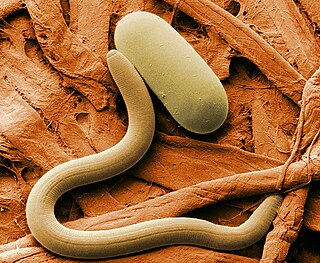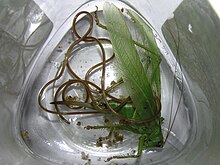
Meloidogyne incognita, also known as the southern root-nematode or cotton root-knot nematode is a plant-parasitic roundworm in the family Heteroderidae. This nematode is one of the four most common species worldwide and has numerous hosts. It typically incites large, usually irregular galls on roots as a result of parasitism.

Secernentea was a class of nematodes in the Classical Phylogeny System and is no longer in use. This morphological-based classification system has been replaced by the Modern Phylogeny system, where taxonomy assignment is based on small subunit ribosomal DNA.

Heterorhabditis is a genus of nematodes belonging to the order Rhabditida. All species of this genus are obligate parasites of insects, and some are used as biological control agents for the control of pest insects.

In nematodes, the gubernaculum is a hardened or sclerotized structure in the wall that guides the protrusion of the spicule during copulation. For example, in Caenorhabditis elegans, spicules serve to open and dilate the vagina of the hermaphrodite and the gubernaculum is a grooved plate in which the spicules move; the gubernaculum is controlled by two erector and two protractor muscles.
Belonolaimus longicaudatus is a common parasite of grasses and other plant crops and products. It is the most destructive nematode pest of turf grass, and it also attacks a wide range of fruit, vegetable, and fiber crops such as citrus, cotton, ornamentals, and forage. The sting nematode is a migratory ectoparasite of roots. It is well established in many golf courses and presents a problem in turf management. The sting nematode is only present in very sandy soils. It cannot reproduce in heavier or clay soils.

Tylenchida is an order of nematodes.
Xiphinema americanum, the American dagger nematode, is a species of plant pathogenic nematodes. It is one of many species that belongs to the genus Xiphinema. It was first described by N. A. Cobb in 1913, who found it on both sides of the United States on the roots of grass, corn, and citrus trees. Not only is Xiphinema americanum known to vector plant viruses, but also X. americanum has been referred to as "the most destructive plant parasitic nematode in America", and one of the four major nematode pests in the Southeastern United States.
Mesocriconema xenoplax is a species of plant parasitic nematodes. Nematodes of this particular species are collectively called ring nematodes.

Nematology is the scientific discipline concerned with the study of nematodes, or roundworms. Although nematological investigation dates back to the days of Aristotle or even earlier, nematology as an independent discipline has its recognizable beginnings in the mid to late 19th century.

The nematodes, roundworms or eelworms constitute the phylum Nematoda. They are a diverse animal phylum inhabiting a broad range of environments. Most species are free-living, feeding on microorganisms, but there are many that are parasitic. The parasitic worms (helminths) are the cause of soil-transmitted helminthiases.

Stichosome is a multicellular organ that is very prominent in some stages of nematodes and consists of a longitudinal series of glandular unicellular cells (stichocytes) arranged in a row along the oesophagus that form the posterior esophageal glands. It opens into the esophageal lumen and apparently functions as a secretory gland and storage organ.

Stichocytes are glandular unicellular cells arranged in a row along the posterior portion of the oesophagus, each of which communicates by a single pore with the lumen of the oesophagus. They contain mitochondria, rough endoplasmic reticulum, abundant Golgi apparatuses, and usually 1 of 2 types of secretory granules, α-granules and β-granules, indicating secretory function. Collectively stichocytes form the stichosome. Characteristic of Trichocephalida and Mermithida, two groups of nematodes.
Heterodera zeae, the corn cyst nematode (CCN), is a plant parasitic nematode that feeds on Zea mays (maize/corn). The CCN has a limited economic impact worldwide due to its high soil temperature requirements.
Globodera ellingtonae is one of the potato cyst nematodes and was recently recognized as a new species in the United States. This triggered a quarantine of the fields where it was isolated to prevent the spread of this nematode to other fields.

In nematodes, spicules, also known as copulatory spicules, are needle-like mating structures found only in males.
Trichodoridae is a family of terrestrial root feeding nematodes, being one of two that constitute suborder Triplonchida. They are economically important plant parasites and virus vectors.
Myolaimidae is a family of nematodes in the order Rhabditida. It consists of two genera, Myolaimus and Deleyia.
May Belle Hutson Chitwood was an American author, nematologist, helminthologist, and zoologist at the Agricultural Research Service, curator of the National Parasite Collection, and director of the primate parasite registry at University of California at Davis. Chitwood specialized in the morphology of nematodes early in the research of this aspect of the species, and was considered a world authority. She published over 50 research papers about nematology, helminthology, and zoology.
Jesse Roy Christie was an American nematologist and plant pathologist.
Benjamin Goodwin Chitwood was an American zoologist and pioneer in nematology. He published extensively and broadly in the field of nematology. An Introduction to Nematology, published with his wife May Belle Hutson Chitwood, was a major contribution to the field. Chitwood identified the species Globodera rostochiensis on Long Island in 1941 and as part of his work on higher classification revised the taxonomy of the root-knot nematode Meloidogyne incognita in 1949. This led to changes in research and control strategies for it. He served as president of the Helminthological Society of Washington in 1949 and was made a Life Member of the Society in 1968.









